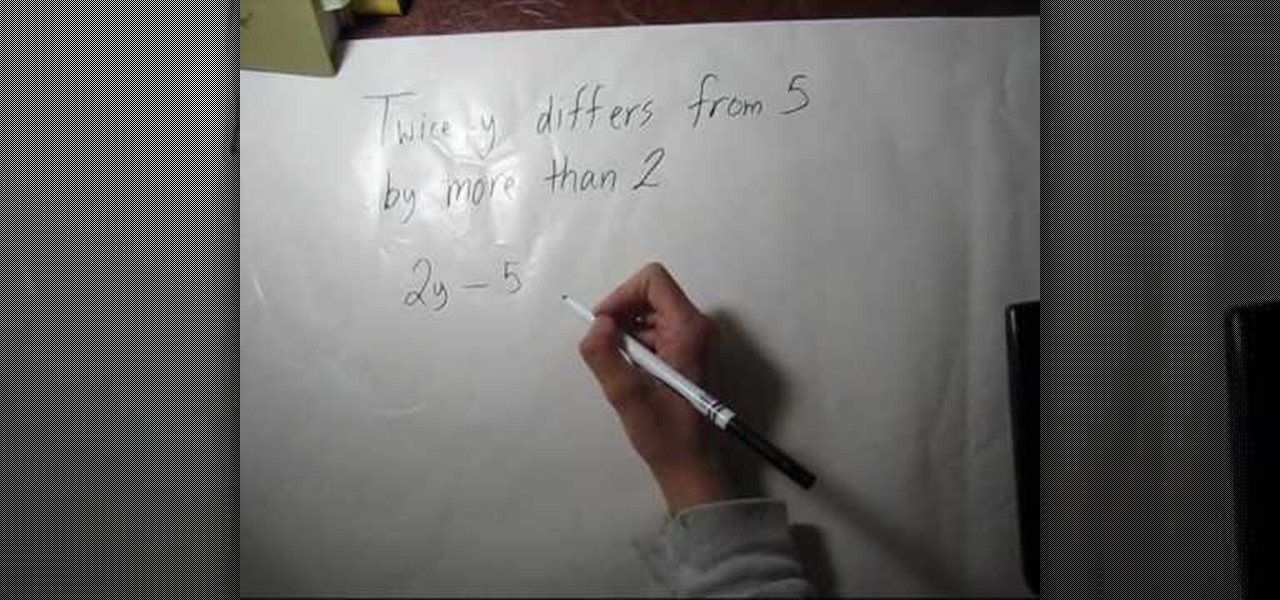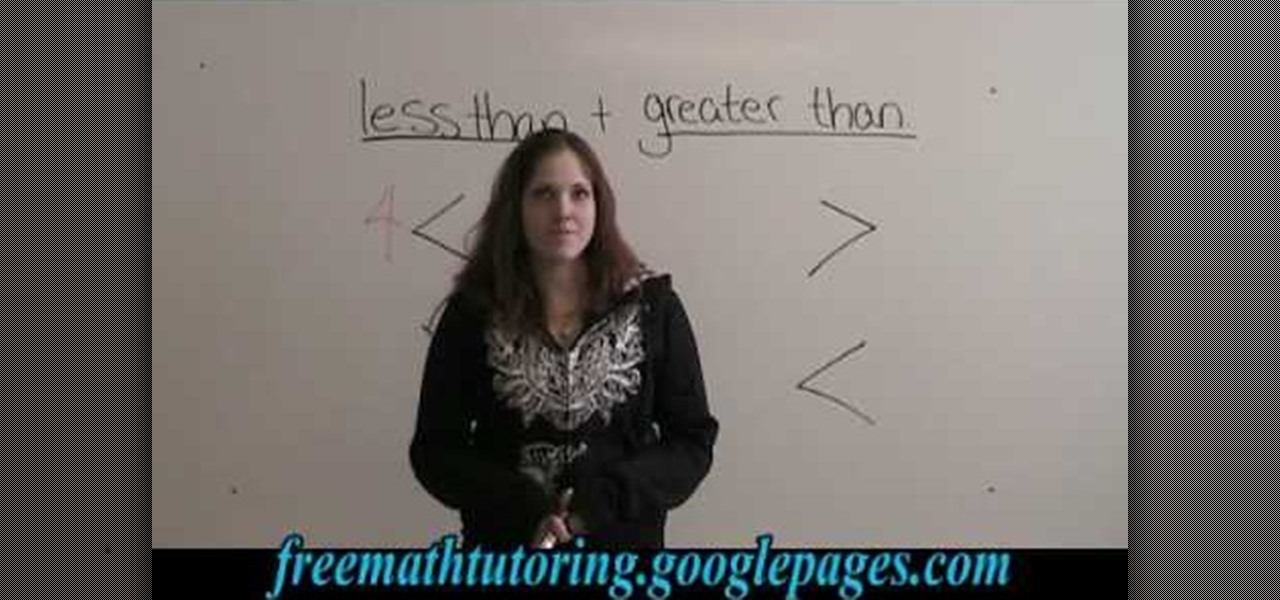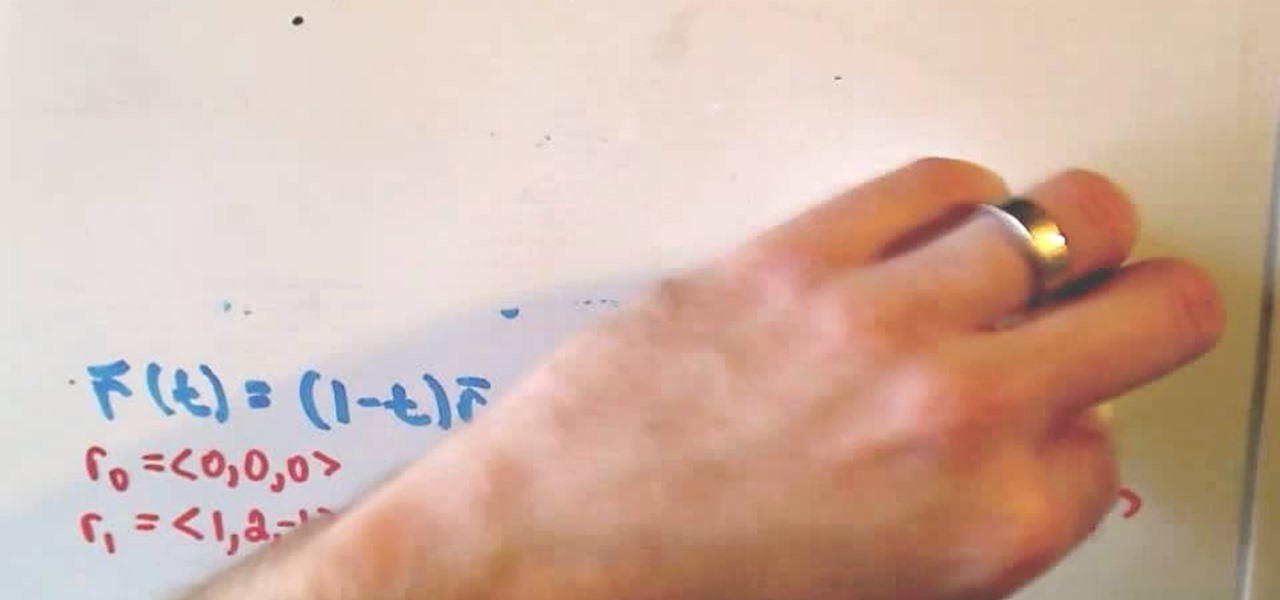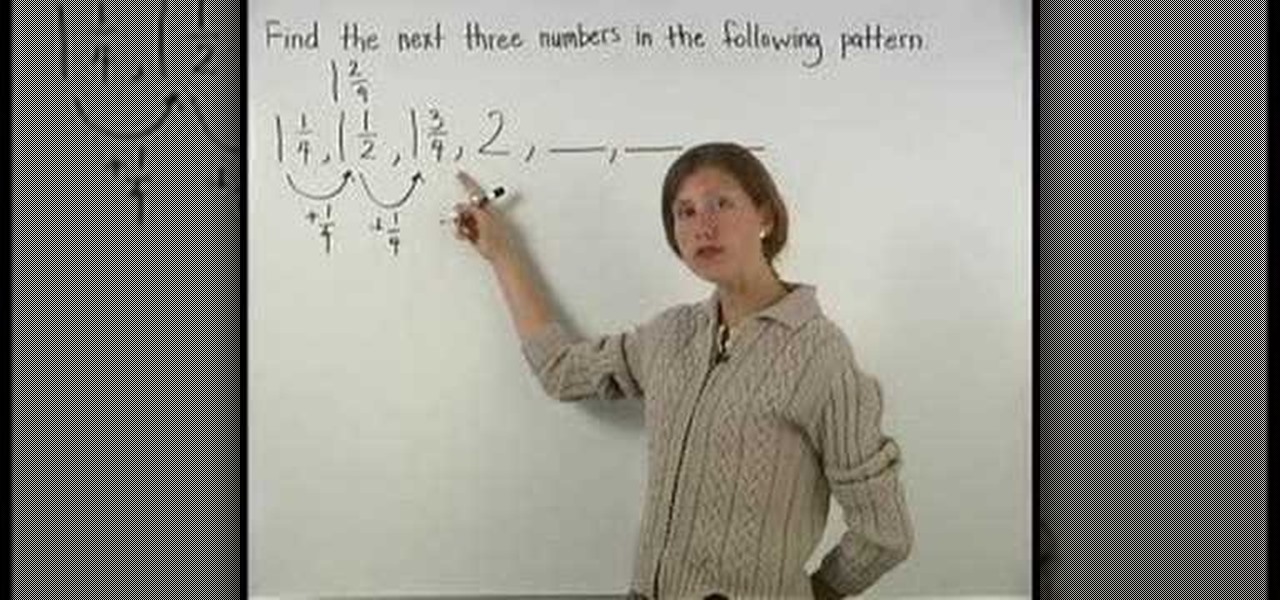Active Math Posts


How To: Solve systems by substitution
You can solve systems by using the substitution method. Here are two examples. One says y=3x+2 and the second says 7x-4y=7. The math teacher explains that if y is the same thing as 3x+2, then 3x+2 can be substituted for y in 7x-4y=7. Once it is substituted, your equation will then read 7x-4(3x+2)=7. The next step is to solve for x. Once you have worked out this equation, you will see that x=-3. Finally, your last step is to solve for y. To solve for y, simply substitute x with -3. The equatio...
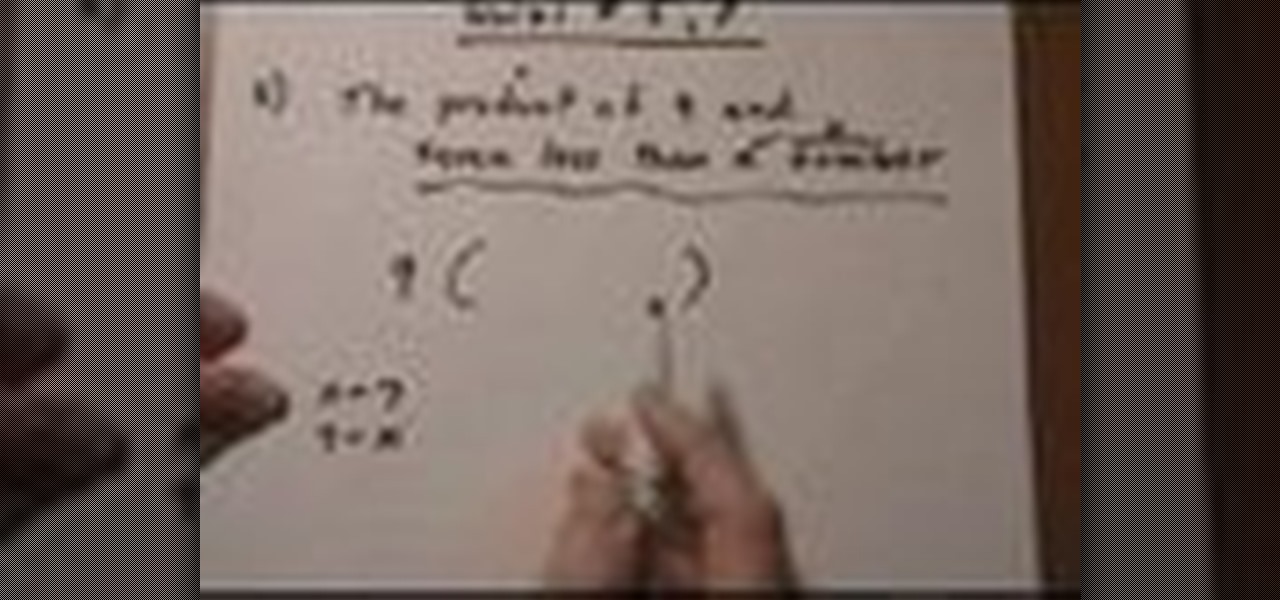
How To: Translate a word problem into algebra
This video shows the method to change a word problem into algebra and to identify rational numbers among a group of numbers. In the first part of the video we take a word problem namely - The product of 9 and seven, less than a number. 9 multiplied by something can be expressed as 9(). The unknown number can be expressed as 'x'. Seven less than a number can be expressed as x - 7, so that the final equation becomes 9(x - 7). In the second part we are given a list of numbers. A rational number ...
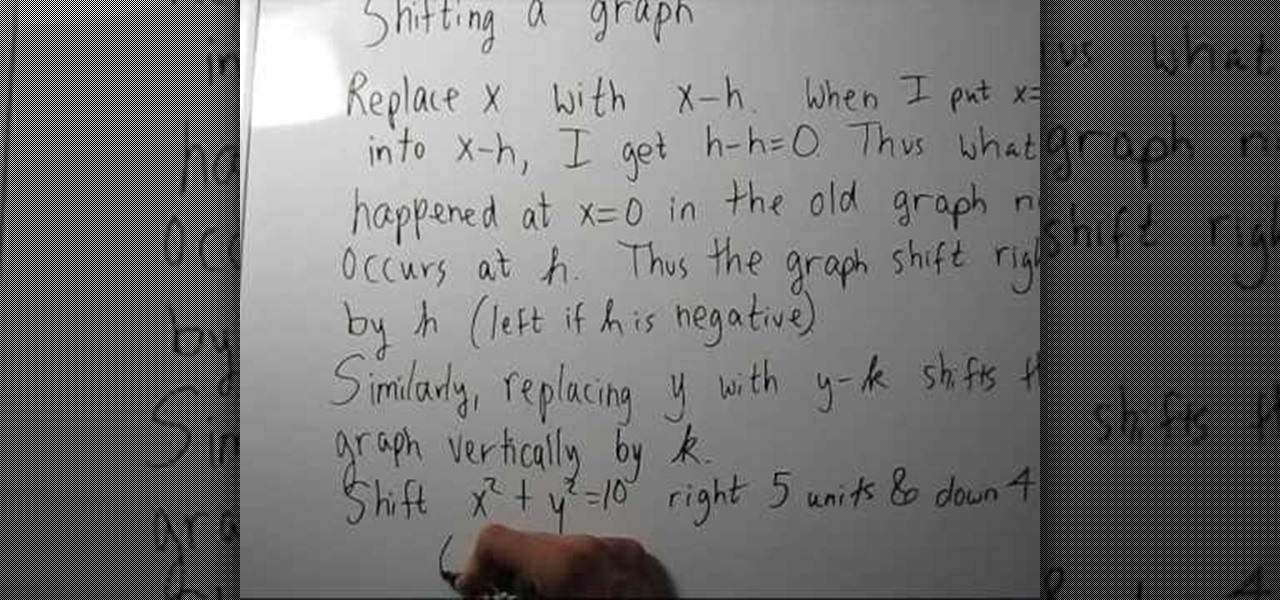
How To: Shift a graph
This video will demonstrate exactly how to shift a graph on a x,y axis. When shifting a graph on the x axis you will need to replace x with x-h; where h is the variable to shift the graph. No matter how far you need to shift a graph, h is always the number of units you are shifting; shifting up or right is represented as a positive and down or left is negative. Just plug in your units into your equation and you will have your shifted graph.

How To: Find points on y-axis a certain distance from a point
This is video on mathematics. It specifically deals with geometry. The video describes how to determine where the y-intersects are when a point and distance to the y-intersect are given. The author starts out by giving an example ordered pair. The speaker next shows an example of how to solve such a problem. The speaker uses the distance formula along with the given distance and x-coordinate in order to solve for the y-intersect values in question. Most of the video entails solving this example.

How To: Simplify square roots
This is a video tutorial on how to simplify square roots. To simplify square roots, one must have the knowledge of splitting numbers into prime factors. For example,12 can be split into 4*3 and further more into 2*2*3. Here we see that all the factors are prime numbers. So the square root of 12 can be written as 2*square root of 3(as shown in the video). The method used in the video is applicable for simplifying any square roots as any number can be split into prime factors. Follow the video ...
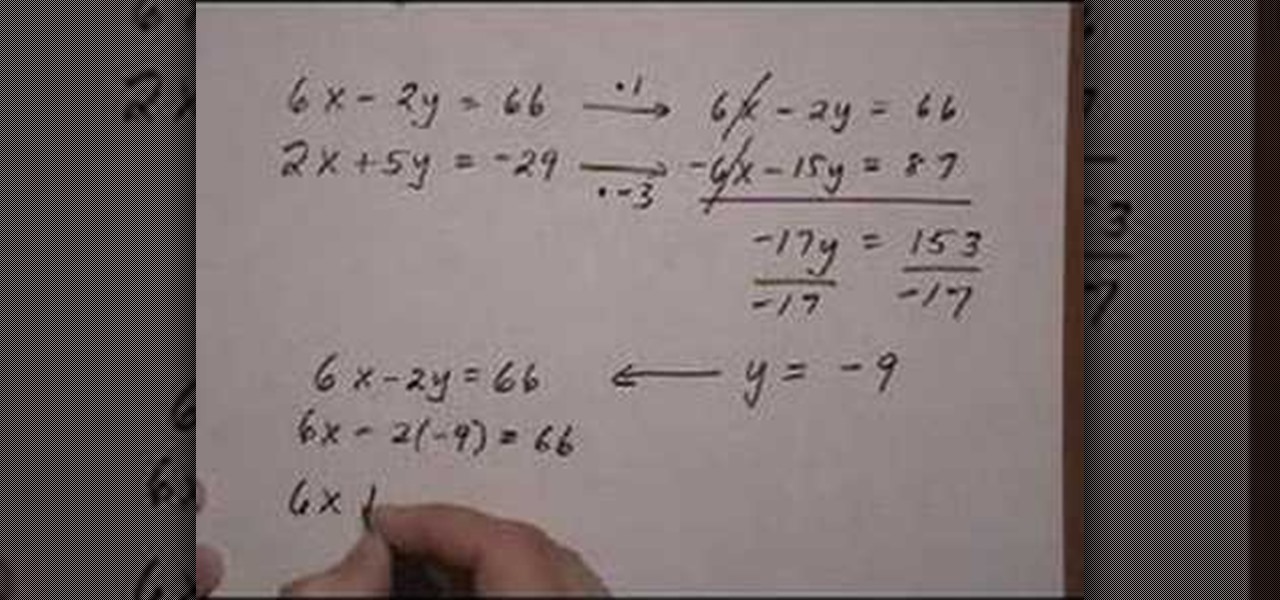
How To: Solve a linear system by elimination method
This video is about using the elimination method to solve a linear system. The lady presenting this video says that elimination method means that one of the two variables has to be eliminated while adding up the two linear equations. She then explains the example equations 6x-2y=66 and 5y=-29-2x. She asks you to first line up x and y. So the second equation is rewritten as 2x+5y=-29. Then she says that, to eliminate a variable, we should have their variables equal in value but of opposite sig...

How To: Handle missing terms in algebraic long division
In this tutorial you are shown exactly how to do algebraic long division when terms are missing in the polynomial. Follow these steps and you can divide whatever you'd like:

How To: Divide rational expressions
In this video the instructor shows how to divide rational expressions. To divide rational expressions follow this simple four step approach. In the fist step change the division to multiplication by flipping the second fraction. Now the original division simplifies to multiplication. In the second step factor the terms of numerators and denominators in the two fractions. In the third step cancel the common terms in the numerator and the denominator. Now finally in the fourth step multiply all...

How To: Complete a proof involving angles
Money math is back for a chill lesson on completing a proof involving angles. This proof touches on complementary angles, definition of congruent angles, Angle Addition Postulate, and substitution. YAY MATH! This video will demonstrate exactly how to complete a proof involving angles.
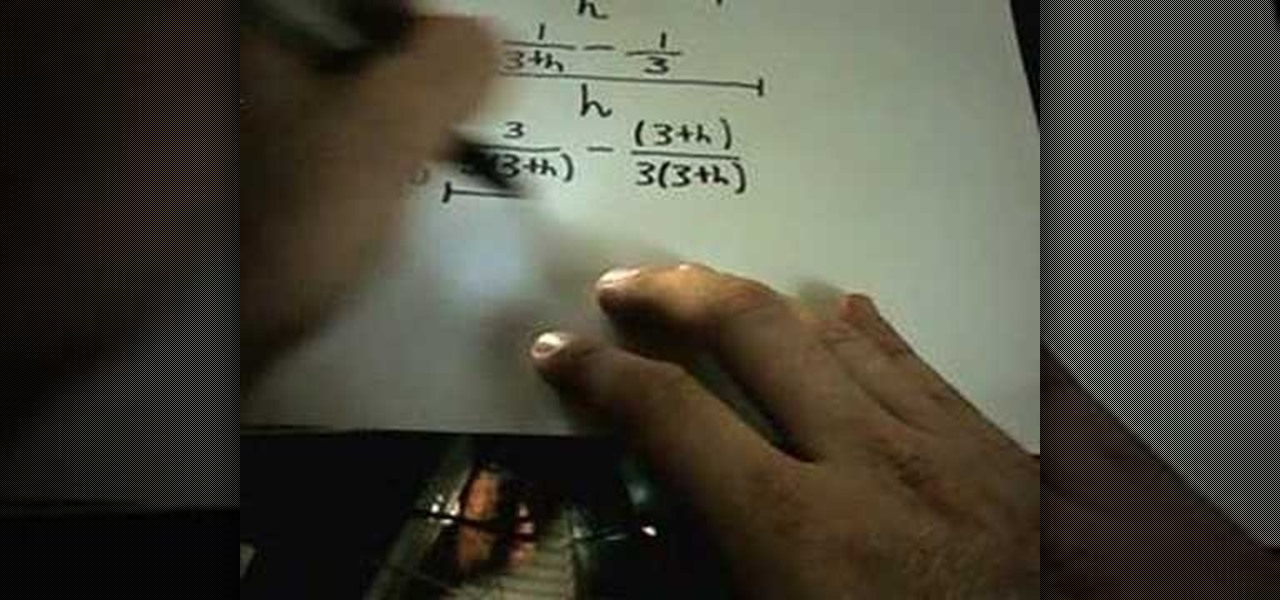
How To: Calculate a limit by getting a common denominator
This video explores how to get the limit by getting a common denominator. When you try and plug in a limit, for example when the denominator goes to zero, you can get yourself into a situation where you get the answer (0/0) which is mathematically irrelevant. To solve this problem, you must find a common denominator and split the problem up into its various parts. By setting common denominators in the numerator, you can then flip the fraction around allowing you to properly calculate the limi...

How To: Multiply mixed numbers for recipies
Despite what we all argued in school, math does come up in daily life. When those dreaded fractions are staring you in the face remember these steps and you will be multiplying in no time. Practice always helps.

How To: Add rational expressions
This is the video about how to add a rational expression. So to add a rational expression first of all find the common denominator. To find the common denominator, just find the least common multiple (LCM) of the denominators. There are at least a couple ways of doing this. To convert each fraction to the common denominator, you multiply each denominator by what it needs in order to turn it into 6x. For instance, in the x+4/5x, the denominator needs to be multiplied by 6x, since 6xX5x = 30x. ...

How To: Graph piecewise defined functions
In this video the instructor shows how to graph a piecewise defined function. A piecewise defined function is a function that is defined in separate pieces. In these kind of functions, for different ranges of the value of x, you are given different small functions, all of which together make the whole function. This means your equation of the function is given in the form of smaller functions. Now to graph these kind of equations all you have to do is graph the individual equations in the sam...
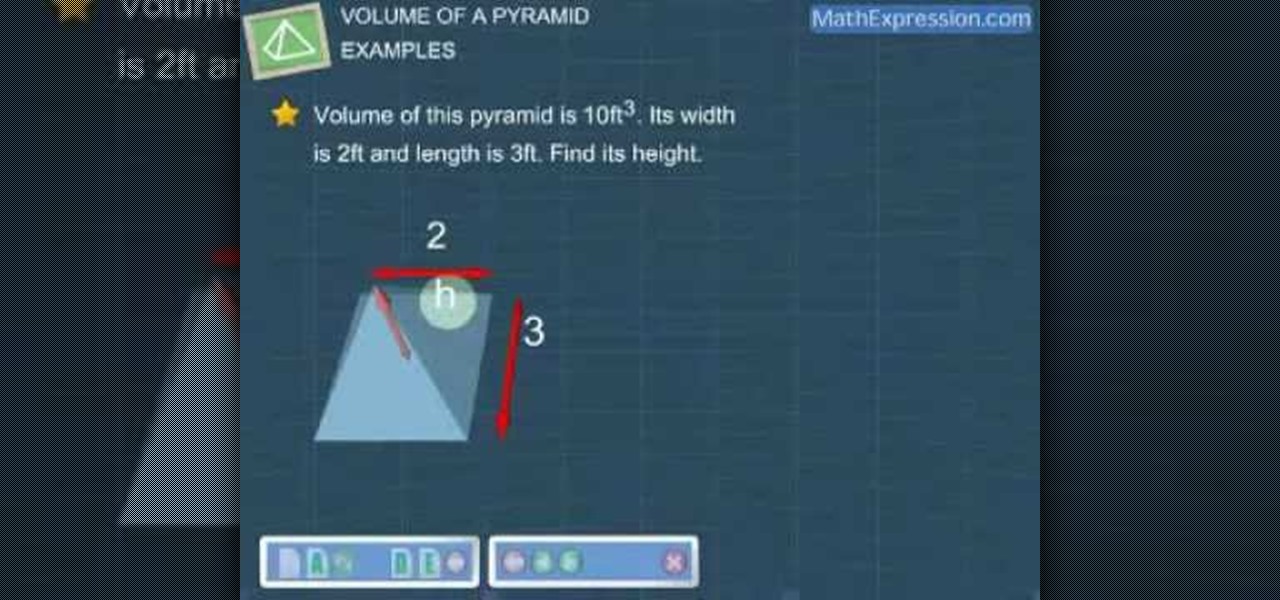
How To: Find the volume of a pyramid
A pyramid is a three dimensional version of the triangle. In this video, learn how to find the volume of a pyramid. Finding volume is the next step after you learn how to find 2D area. Check out this tutorial and soon you will be tackling 3D objects just as easily as you learned their 2D cousins.
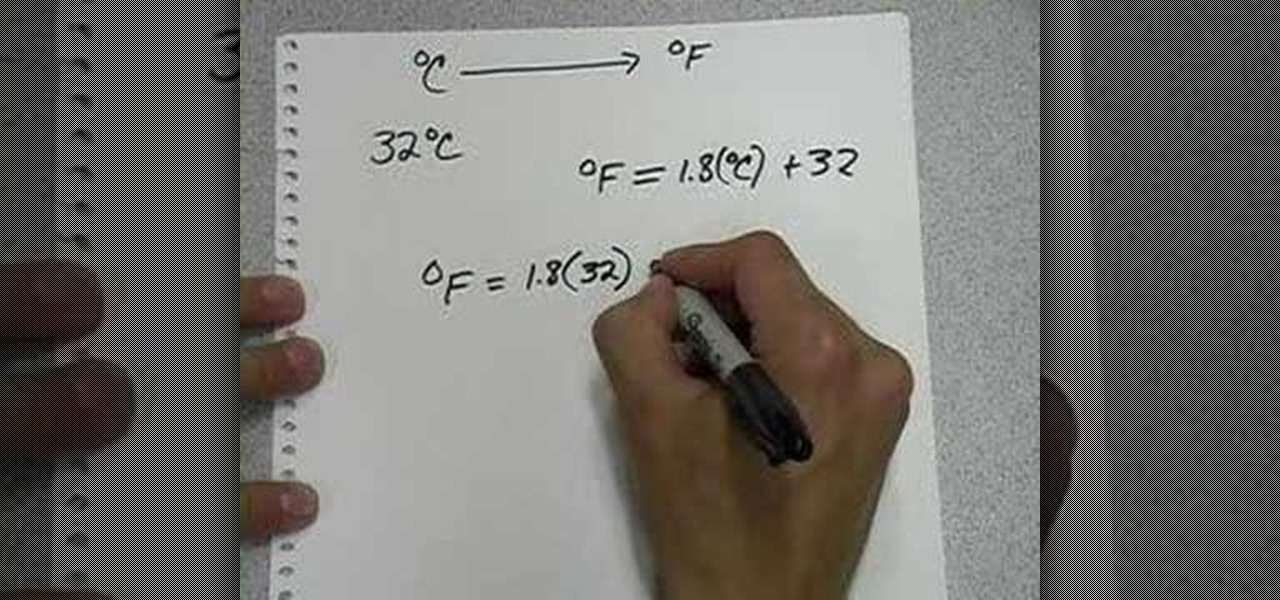
How To: Convert temperature measured in Celsius to Fahrenheit
This video teaches how to convert a value in Celsius to Fahrenheit in simple steps. First take a paper and marker and keep in mind a Celsius value (e.g-32) to convert into Fahrenheit. Now use the formula to convert Celsius to Fahrenheit which is F=1.8(32)+32. Use a calculator to calculate the formula and you will get the result as 89.6 Fahrenheit. Now round it off the and your final result will be 90 degree Fahrenheit.

How To: Multiply mixed numbers with whole numbers
This video shows us how to multiply mixed numbers with the whole numbers. First thing you need to do is to change the mixed number into an improper fraction by multiplying the denominator with the whole number and add the resulting number with the numerator. The resulting number will be placed as a numerator with the denominator being the same. Next, is that we can't multiply a fraction with a whole number. So we need to change the whole number into a fraction and this is done by putting the ...
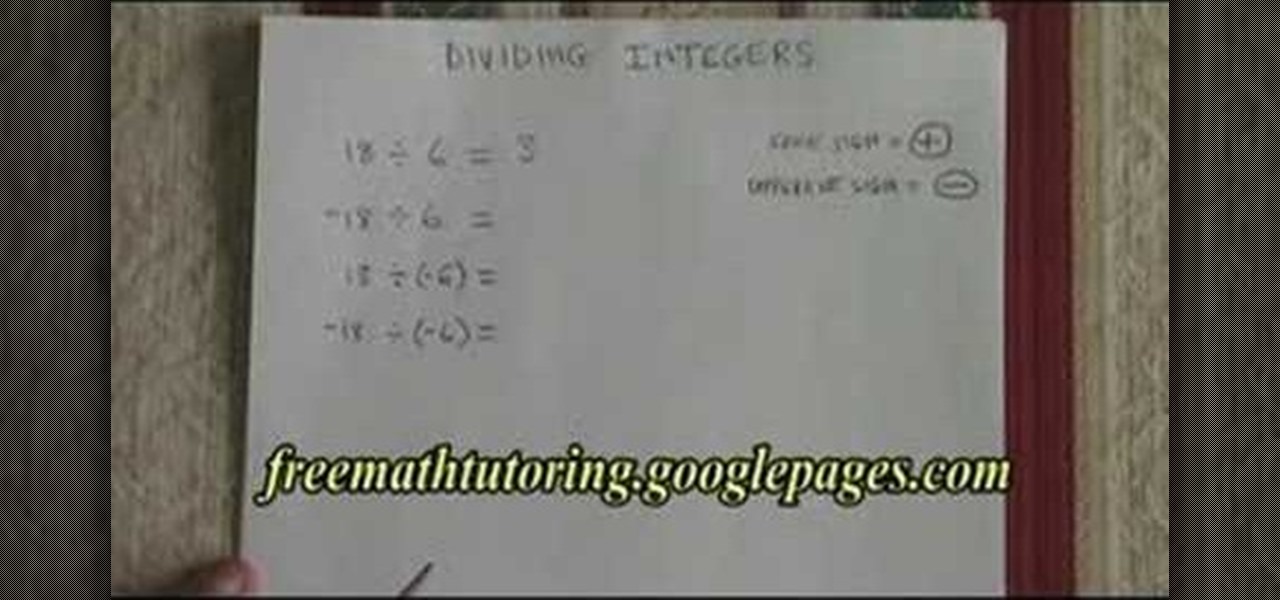
How To: Divide integers
This short video shows basic math integer division. It shows examples of how dividing a positive integer with another positive integer will yield a positive result, whereas diving a negative integer with a positive integer will yield a negative result. This exemplifies the fact that when the signs are different in division, the result will always be negative. This video can definitely help young math students get a better grip of basic integer division and thus have a stronger footing from wh...
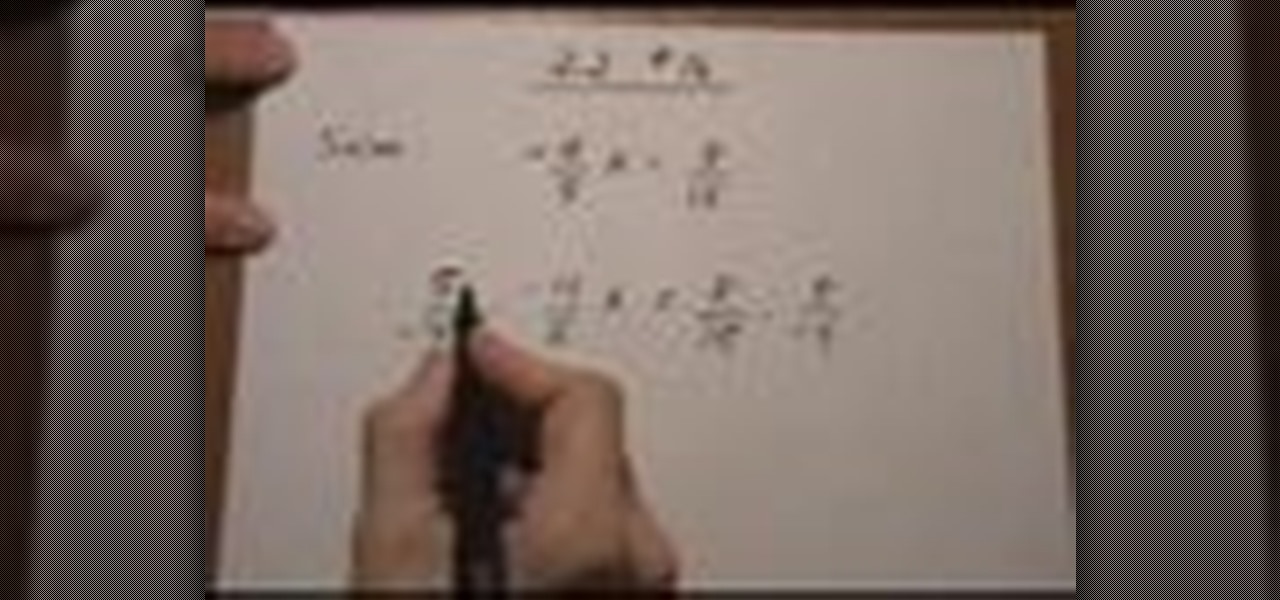
How To: Solve linear equations w/ the multiplication property
This video demonstrates how to solve a linear function with rational coefficients by multiplying by the reciprocal of the coefficient. The reciprocal is just a fancy way of saying the numerator and denominator are swapped. Two sample problems are solved using this method. Multiplying each side of the equation by the reciprocal of the rational coefficient of the variable 'x' is an allowed operation, but only because both sides are multiplies by the the same amount. The teacher then demonstrate...
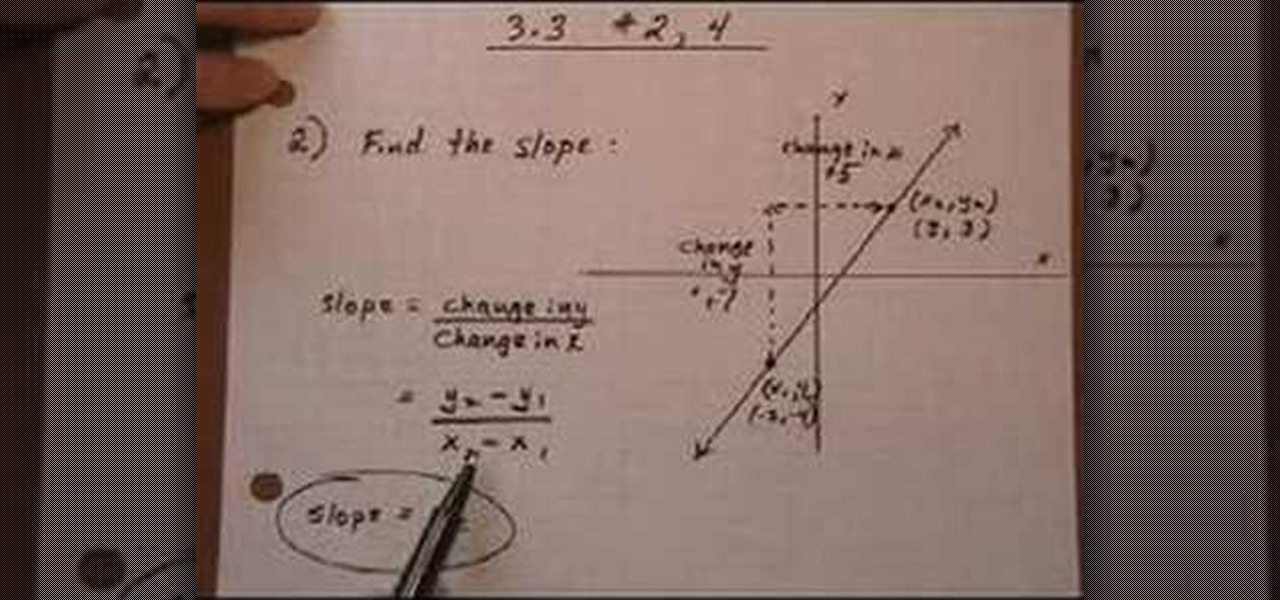
How To: Find the slope from a graph
To do this, there are many ways to approach this problem. One way is to look at the change in Y over the change in X by looking at the points on the graph. Another way is to use the equation Y2-Y1 over the equation X2-X1. In other equations where you are given a graph, you may be asked if the slope is positive, negative, or zero. To determine this, look at the line in the context of moving from left to right along the graph. If the line graphed is going down as you move from left to right, th...
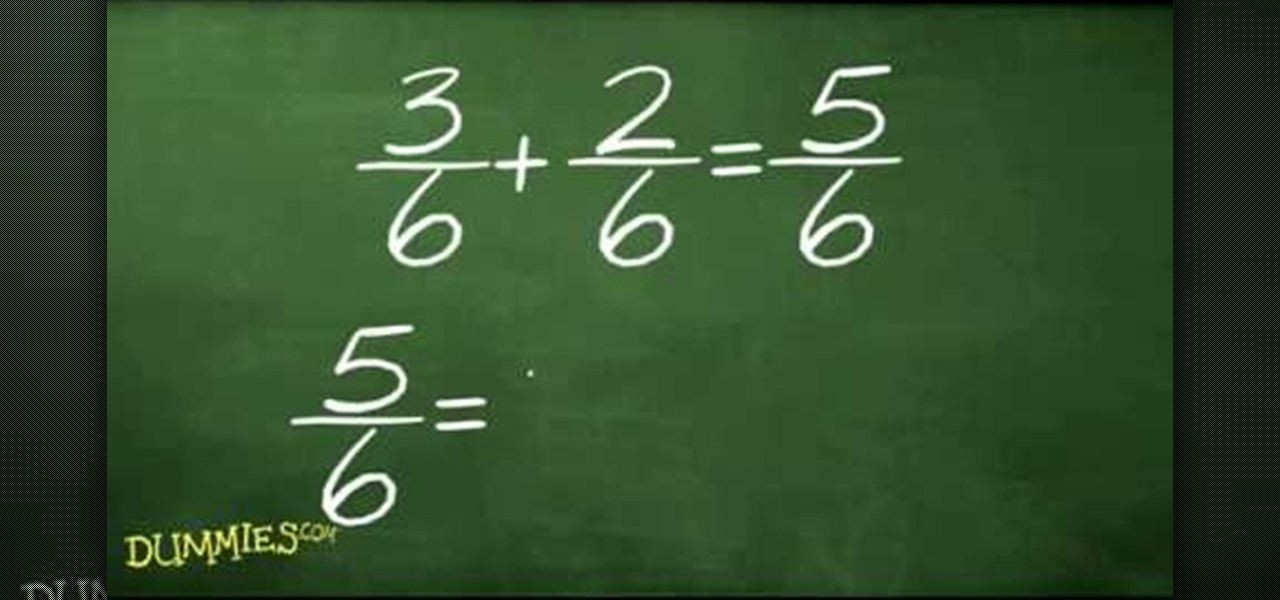
How To: Add or subtract fractions with math
Learn how to add or subtract fractions with math in simple steps. First convert any story line you have into a fraction. Now you have to convert the denominators so that both the fractions have the same. To do so multiply both the numerators and denominators with the same number. Now when you have the same denominators add the numerators to get the answer. Reduce the fractions to a lower value if you wish. Try this out with some other examples.
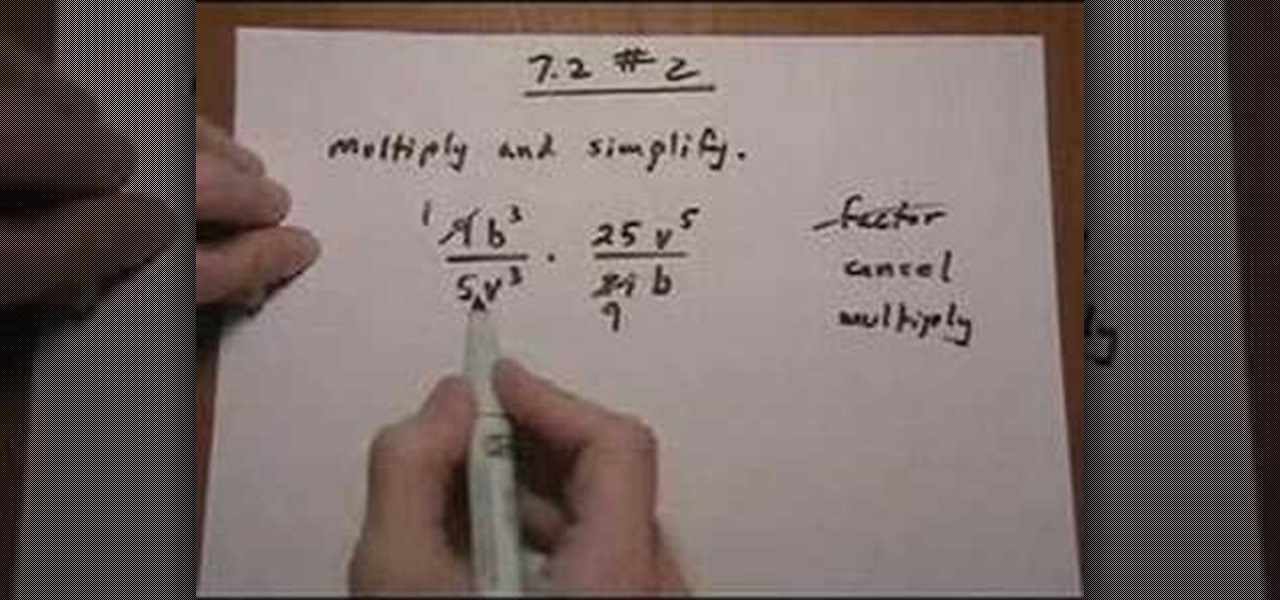
How To: Multiply rational expressions
The video describes the basic process of multiplying two rational expressions. The problem illustrated in this video involved multiplying rational expressions of monomial terms with integer coefficients. As with the other example problems, we follow the steps of: factoring, canceling, and multiplying. Because these terms are monomials, no factoring is required (but we still state it as a step for similarity to solving other problems). We then find the greatest common divisor for both terms to...

How To: Find the circumference of a circle
Use a simple mathematical formula to find the circumference of a circle. The circumference of a circle can be determined by using the formula 2 times pi times the circle's radius. Pi is equal to 3.14. If a circle's radius is 10 centimeters, first multiply pi times 2. Pi, or 3.14, times 2 is 6.28. The next step then is to multiply 6.28 times the circle's radius. Since the circle's radius is 10 centimeters, multiply it by 6.28. This gives you 60.28. 60.28 inches, then, is the circumference of t...
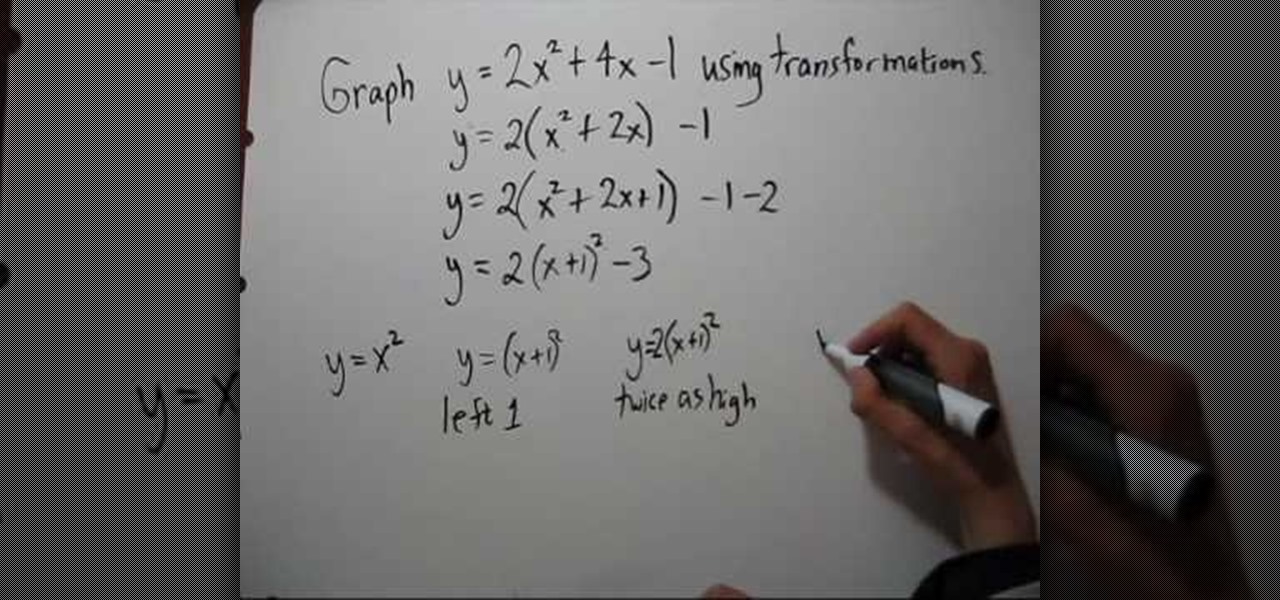
How To: Complete the square to graph a quadratic function
In this tutorial the instructor shows how to complete the square to graph a quadratic function using transformations. You can do this by transforming your equation in a series of steps. First make the coefficient of the square term to one by pulling out its numerical coefficient. Now to complete the square of the first part add half the coefficient of the variable with a degree one. Now to maintain the original value of the equation also make sure that you subtract the same value from the equ...
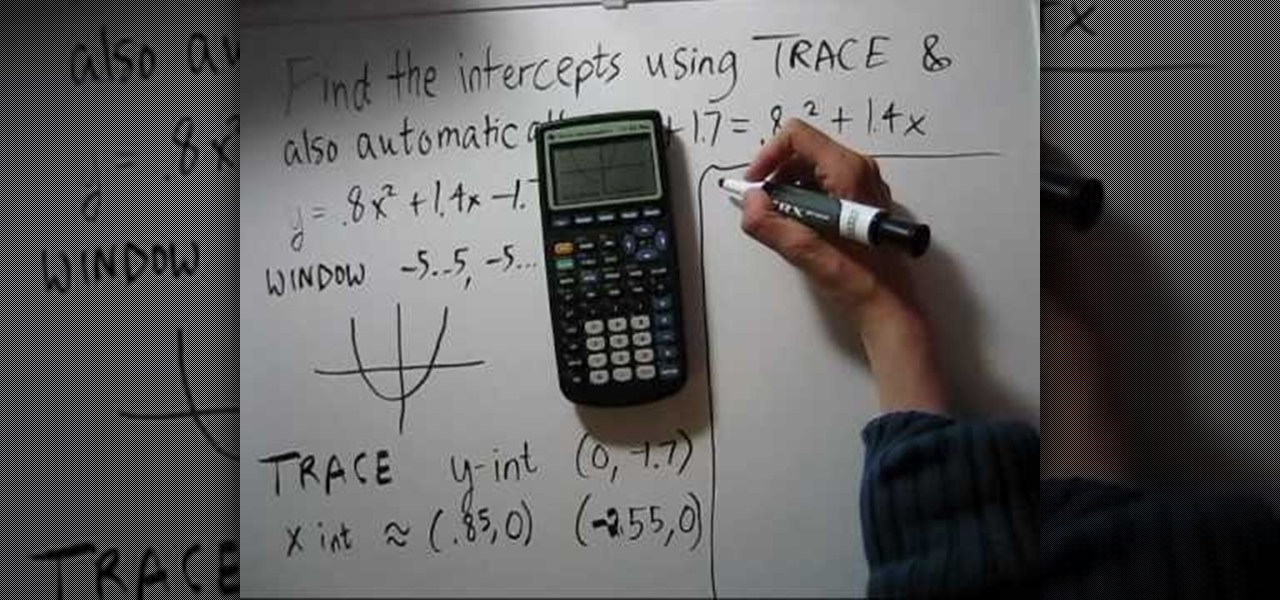
How To: Find intercepts on a calculator TI-83
NotesCollegeAlgebra teaches you how to find intercepts on a calculator TI-83. You start with y plus 1.7 equals .8 times x squared plus 1.4 times x. First you subtract 1.7 from both sides, you get y alone on one side. The window should be set to -5...5, -5...5. X scale should be at 1, y scale at 1 and x rez at 1. Make a graph for it, like a parabola. Use trace to get y intercept at negative 1.7. The x intercept is about .85. Continue to use the calculator to get all the values that you need.
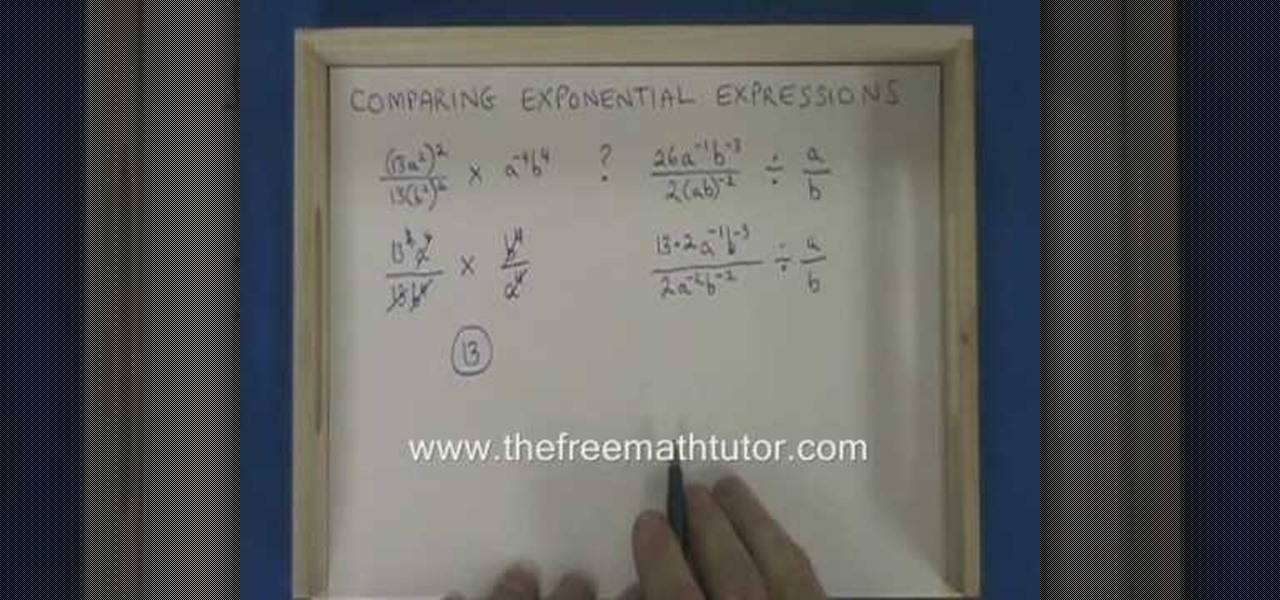
How To: Compare exponential expressions
In this video the tutor shows how to compare exponential expressions and judge if they are equivalent. He shows how to do this using examples to simply exponential expressions. Now after simplifying the numerator and denominator separately he reduces the fraction to arrive at a simple value. Now using this simple values we can compare them and judge if both their values are equivalent. This video gives a good introduction on how to simplify the exponential expression and how to compare them a...
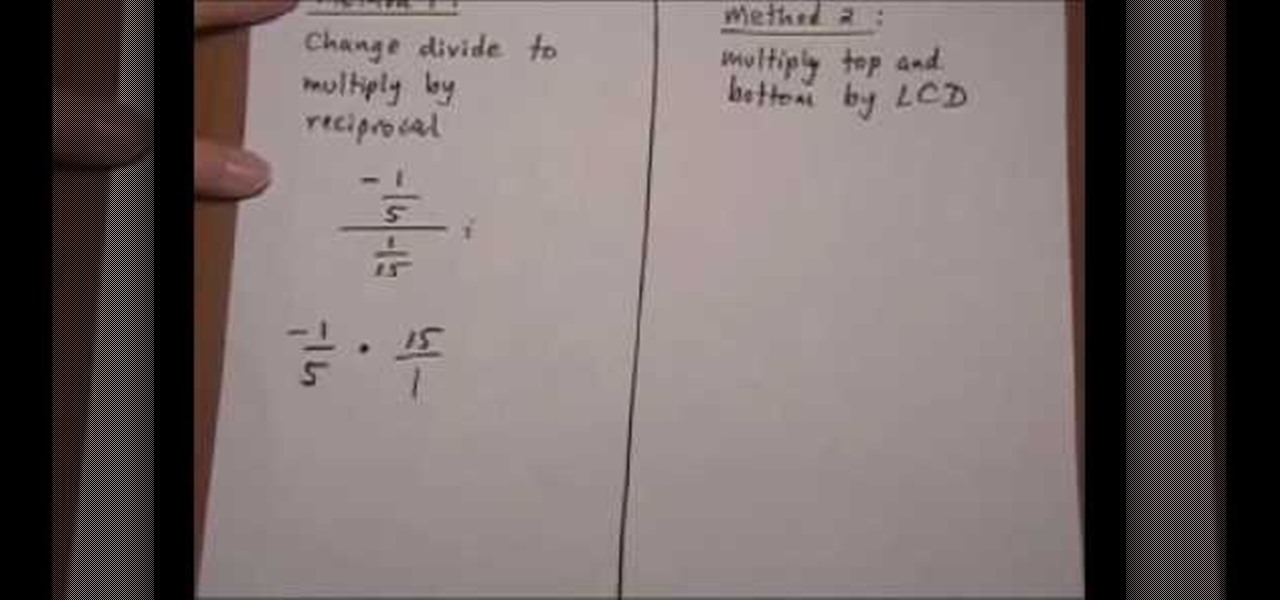
How To: Simplify complex fractions
In this video you can learn how to simplify complex fractions. Look at the example in the illustration. To simplify this complex problem, you would first add the number 1 under the whole number in the denominator, to make it a fraction. Then change it from a division problem by simply inverting (flipping the numbers over) in the second part of the problem. Then multiply the numerators and the denominators across and simplify the problem further, if necessary. To simplify this complex problem,...
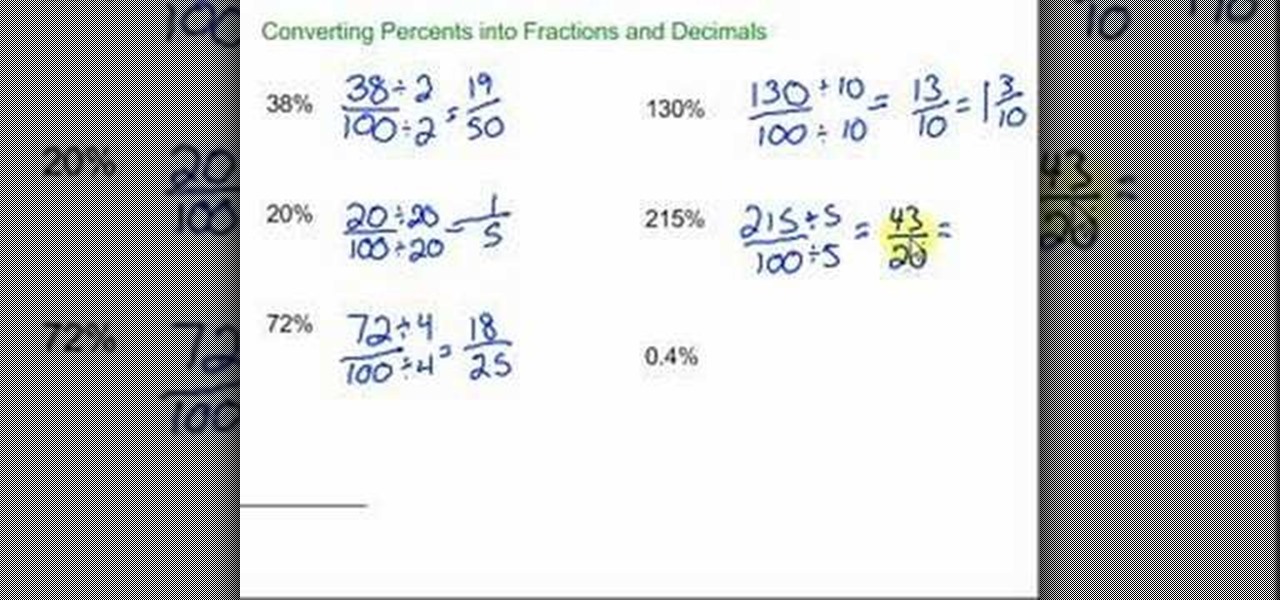
How To: Convert percents into fractions and decimals
This video shows you how to convert percents to fractions and decimals To convert percent to decimal or fraction it is important that we know the meaning of percent which is per 100. So to convert a percent to fraction is simply to put in over 100 and simplify. Now to convert percent to decimal is to move the decimal point two spots to the left. if you don't see a decimal point, it is understood that is behind the last digit of the number.
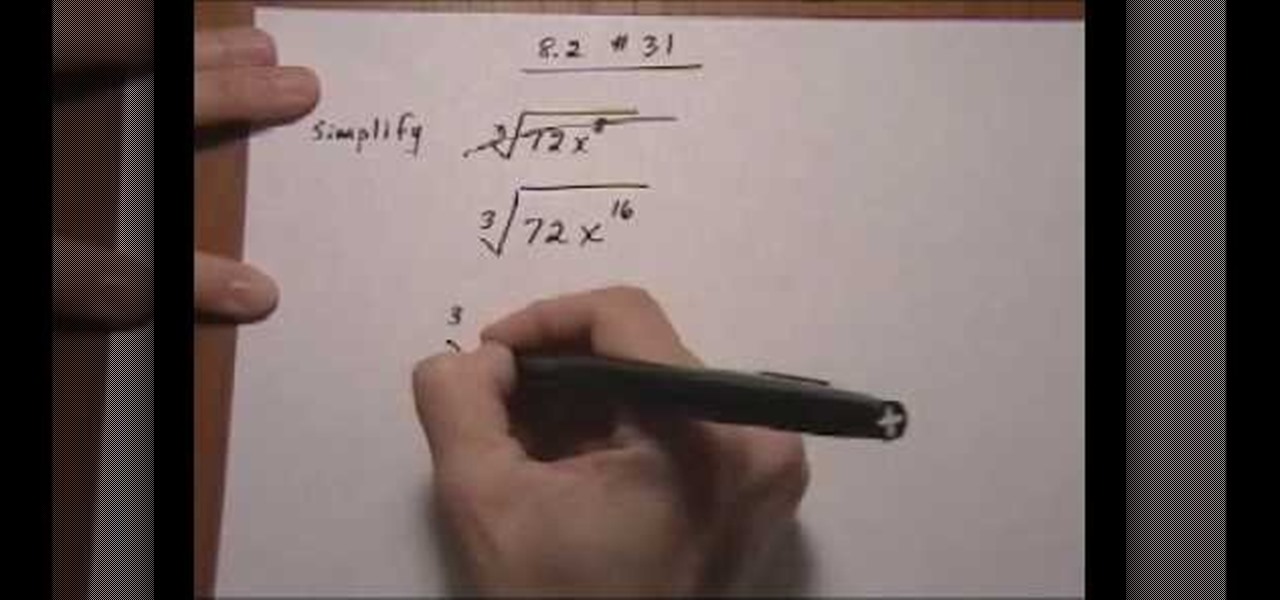
How To: Simplify cube roots
In this video, the narrator presents the viewer with a quick, painless way of simplifying cube roots. The narrator presents many methods to simplify square roots to appeal to different learning styles. By doing things like dividing the power by the root to figure out the power of a number x, the viewer is better able to tackle square-rooting numbers that may not have friendly roots. The video gets more complex as it goes on, eventually teaching the viewer to split the inside of a root up if t...

How To: Graph a linear equation using slope and y-intercept
In this video tutorial learn how to graph an equation using the slope and y-intercept. To show how this can be done, the equation 4X-5Y=20 is used as an example. The first step that needs to be done is to convert the equation into the y=mx+b format where m is the slope and b is the intersection of the y-intercept. Simply solve the equation for Y and you get Y=4/5X-4. From this, you will find that the slope, or m, is equal to 4/5 and that b is the coordinates 0 and -4. On the graph, you will w...
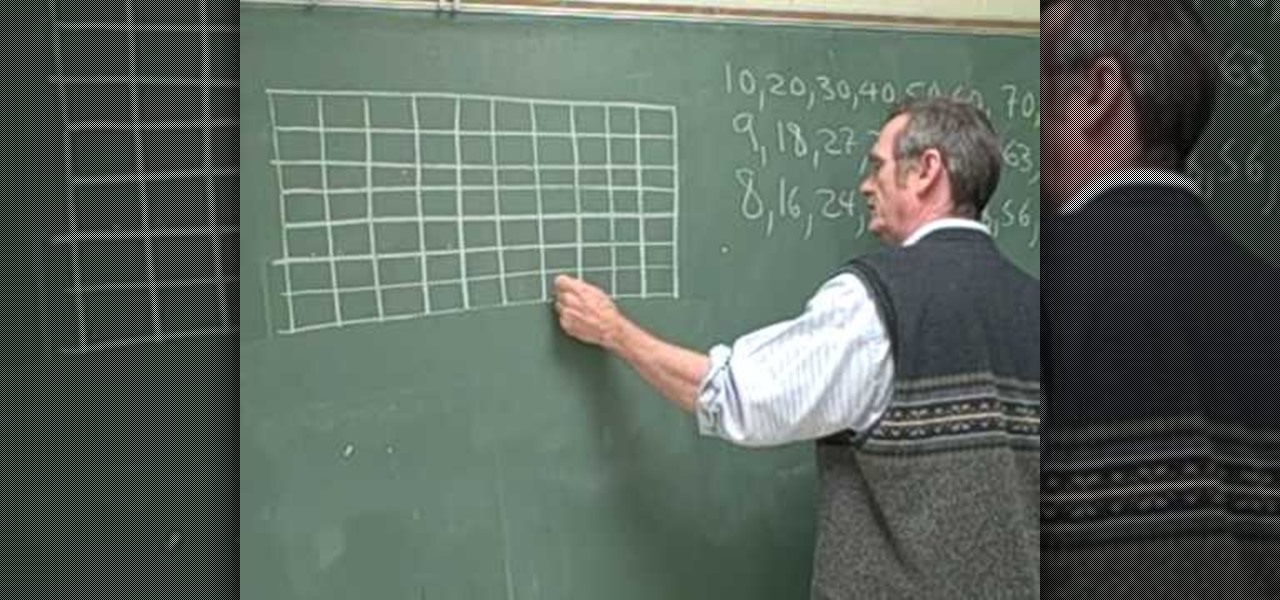
How To: Teach your children to multiply early
The gentleman, acting as the Instructor, starts the session immediately by suggesting that to teach early multiplication all parents should practice a method of "Count-by's" with their children when they are very young using ones to ten, twos to twenty, threes to thirty, fours to forty, and so forth. The Instructor then demonstrates this method of counting by tens using a grid behind him on a chalkboard which depicts columns of ten elements. He counts each column from 10 to 100, and then writ...
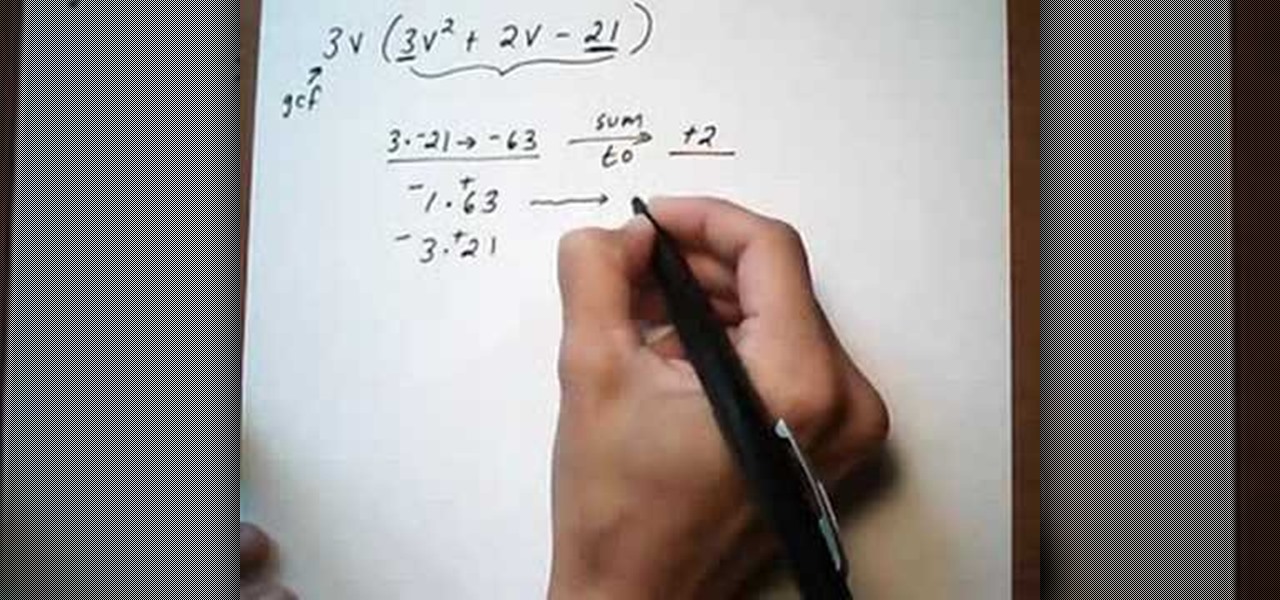
How To: Factor a trinomial by GCF then grouping
In this tutorial the instructor shows how to factor a trinomial with Greatest Common Factor (GCF) and then how to group it. The first thing you have to do when you want to factor a trinomial is look for the GCF. First factor the numerical coefficients of the terms of the equation. Now separate out the common numerical factor and if any common variable. This leaves you with a binomial to be factored. Now to solve this multiply the numerical coefficients of the first term and the last term and ...
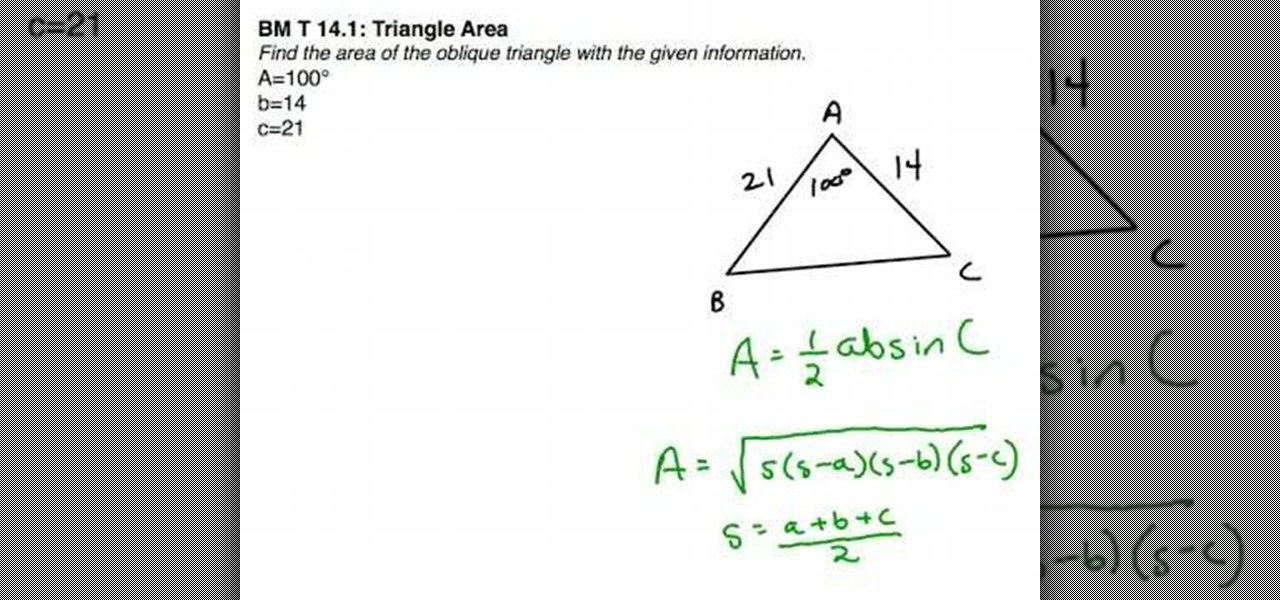
How To: Find the area of an oblique triangle using formulas
In this tutorial the instructor shows how to find the area of an oblique triangle using different formulas. To find the area of an oblique triangle there are different formulae. The first formula to calculate the area of a triangle is area A = (1/2) * a * b * Sin(C), where a and b are the lengths of the two sides of the triangle and C is the value of the angle of the triangle that lies in between the two sides a, b. Now substitute these values in the given formula to find the area if you have...
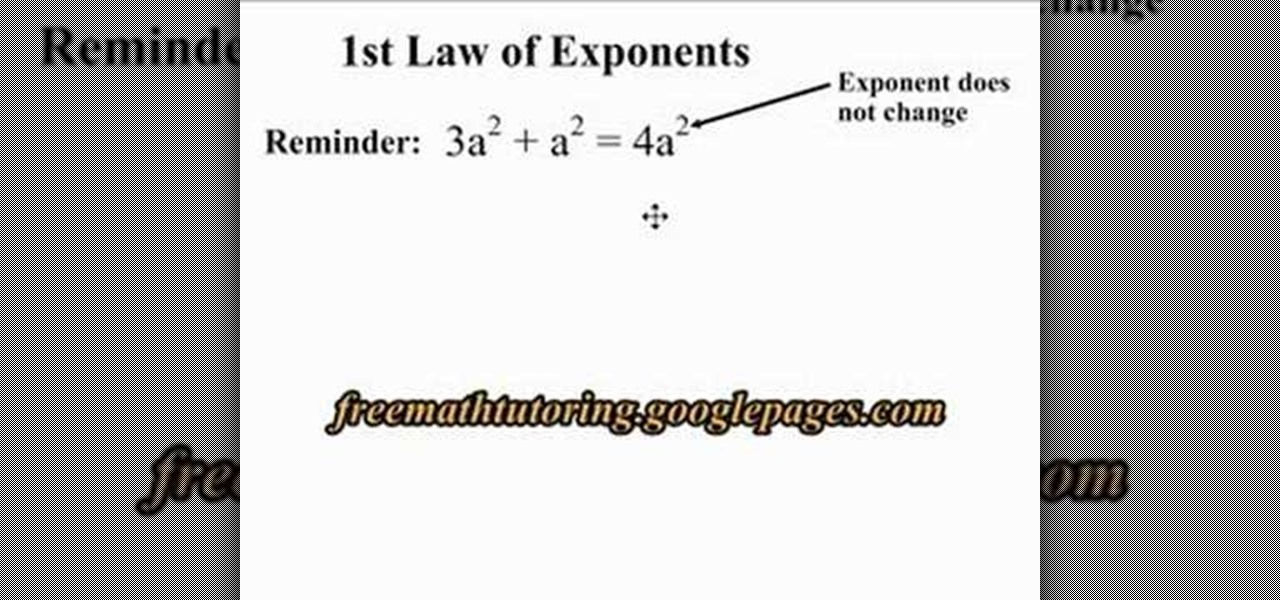
How To: Apply the 1st Law of Exponents
In this video tutorial the author explains the concept of 1st Law of Exponents using an example. He shows that when we add polynomials the exponents does not change but when you multiply two polynomials their exponents change. He says that the new exponent is the sum of the first polynomial exponent and the second polynomial exponent. He further demonstrates this with a good example. This video clear shows with an example about the concept of the 1st Law of Exponents using it to multiply two ...

How To: Evaluate logarithms using a calculator TI-83
A video to help calculator users find the natural logarithm (log base e, or "ln") and standard logarithm (log base 10, or simply "log") of any number using a TI-83 calculator (works for any issue of the TI-83 calculator or even a TI-84 calculator). Turn on your calculator. To find the natural log of a number, press the "ln" button (the third button from the bottom left), enter the number you want to find the natural log of, press the ")" (closed parenthesis) button, then press enter. The same...
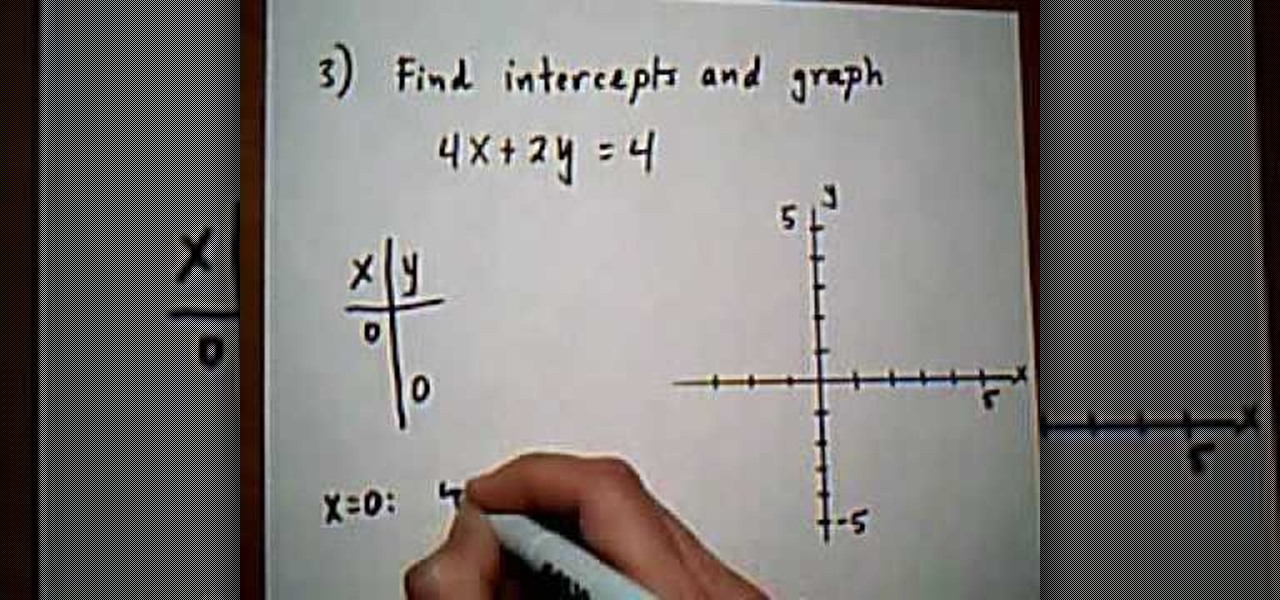
How To: Find intercepts & use them to graph linear equations
The first question asks for the intercepts x and y. To find X, you would need to set Y to zero, leaving the equation 3X=6. X then equals 2 after you divide both sides by 3. The X intercept that you found is not just the value of 2, but it is the ordered pair X=2 and Y=0 on a graph. To find Y, you would do the same thing, except this time X would be set to 0. In the second example of this video tutorial, you will actually learn how to graph the X and Y intercepts. To do that, you follow the st...
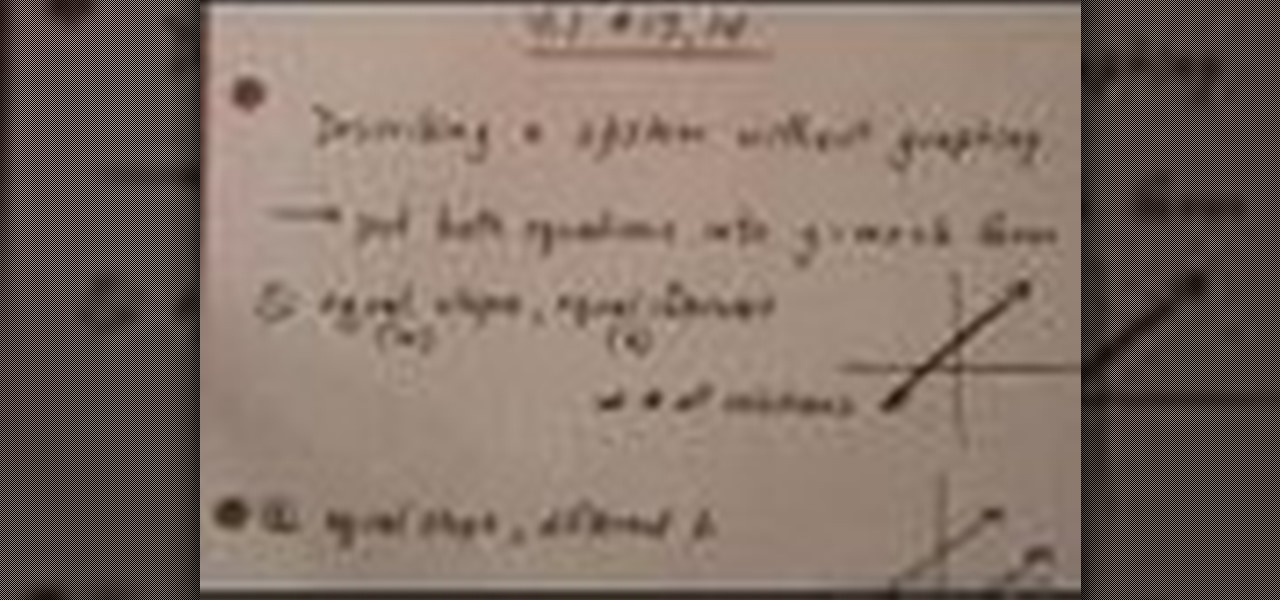
How To: Describe a linear system without graphing
This tutorial looks at how to describe a linear system without actually graphing it. In order to do that, you will need to convert both equations of a problem into the Y=mx+b format. Once you have done this, you will be analyzing the m and b values. There are a few rules to follow. If the slopes (or m) and the Y intercepts (or b) are equal, there are an infinite number of solutions (or dependent equations). A second rule is if the slopes are equal and the Y intercepts are different, then the ...

How To: Do algebraic long division
In this video, you can learn how to do algebraic long division. Take an easy example, such as 88 divided by 4. You are actually dividing 4 into 88. You take the 4 and divide it into the 80, and your answer is 20. Multiply (20 x 4) and you get 80, then subtract the 80 from 88 and you get 8. You then divide 4 into the remaining 8 and your answer is 2, giving you a final answer of 22. Try a harder problem, such as 2105 divided by 12. You are dividing 12 into 2105. The easiest way to handle this ...
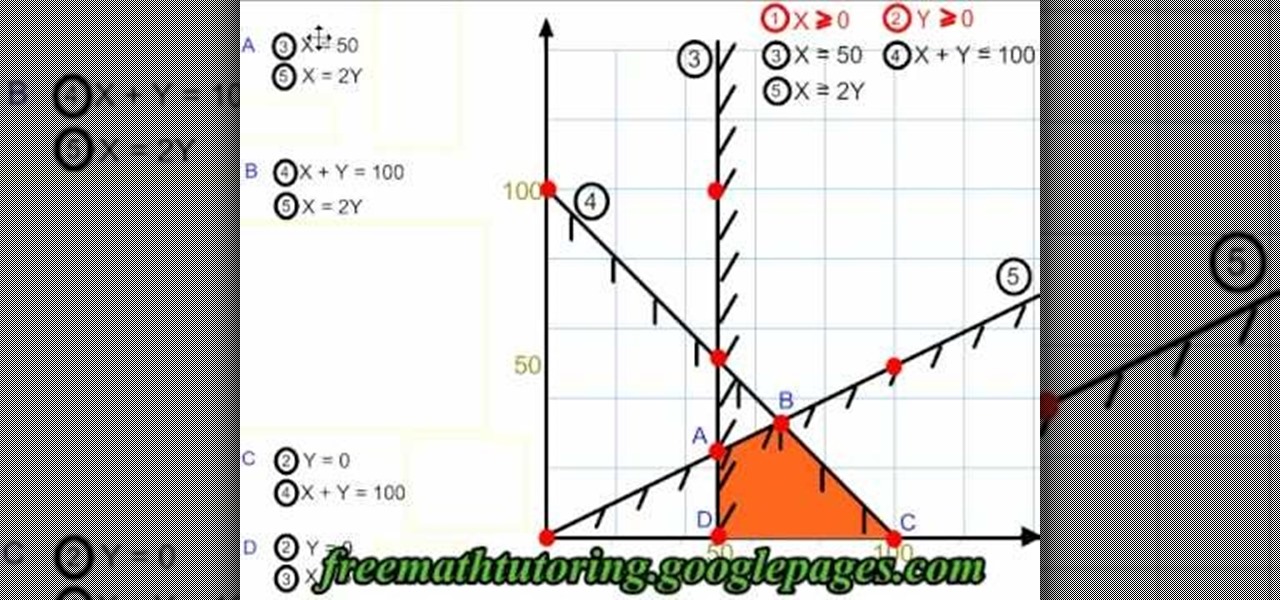
How To: Find the vertices of a polygon of constraints
In this tutorial the instructor shows how to find the vertices of a polygon of constraints. In any optimization problem after defining your polygon you need to find its vertices. First you will have a set of equations which represents the constraints in your problem. Now you have to find the coordinates of the vertex of it by solving the optimization problem. To do that you have to start with a point and check the lines that are passing through it. Now take those lines and solve them for the ...
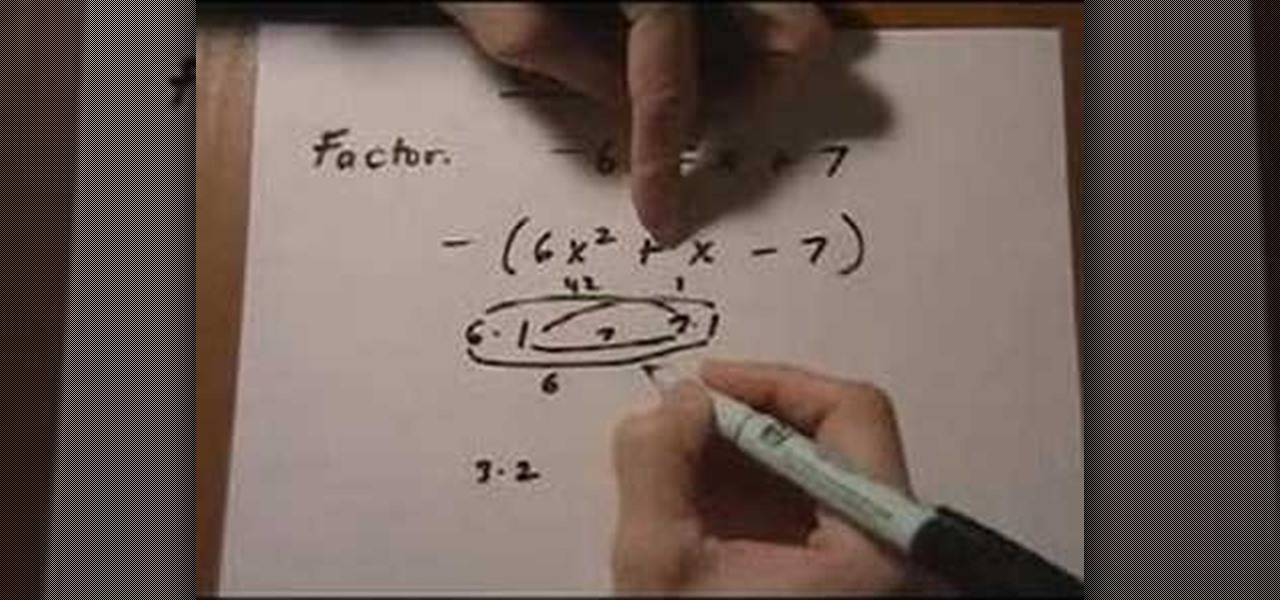
How To: Factor a trinomial with a negative in front
This video shows the method to factor a trinomial with a negative sign in the front. The first step is to make the first term positive. This is done by taking the negative sign out. Then we see the middle term of the trinomial. The coefficient of the middle term is a positive one in the example shown. We have to group the coefficient of the first and third term in a way so that the difference is positive one. The appropriate combination is chosen so that this becomes true. In this way the tri...
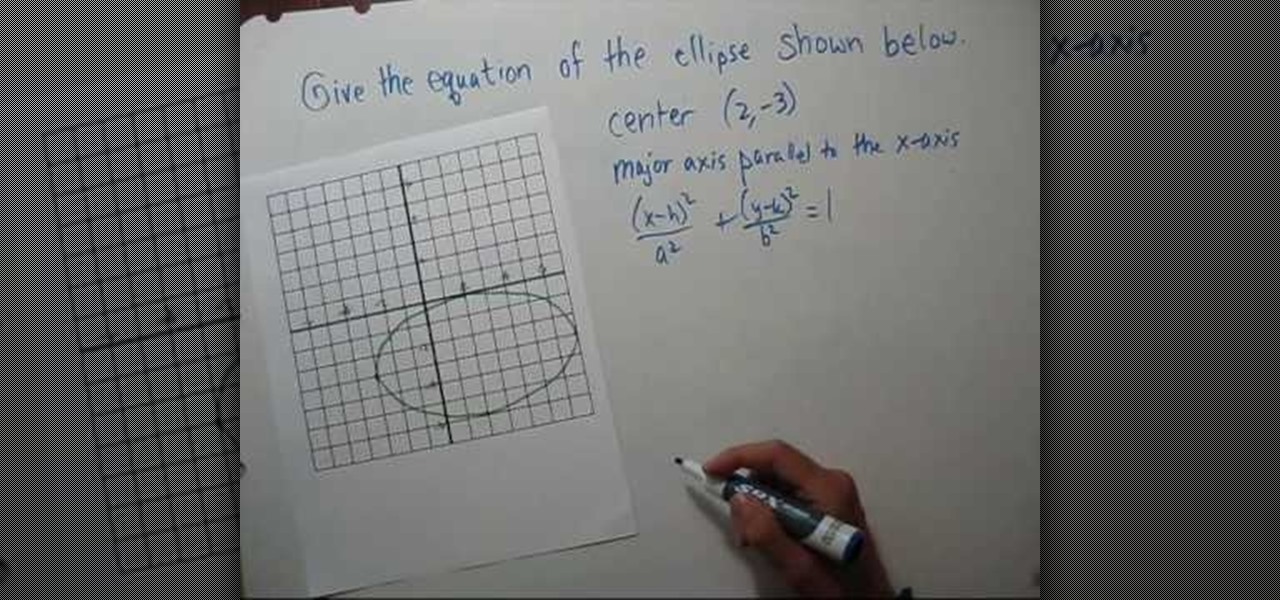
How To: Find the equation of an ellipse given a graph
Notes College Algebra teaches you how to find the equation of an ellipse given a graph. You first want to find out the center of the ellipse, which in the video is (2, -3). The major axis is parallel to the X axis. The equation is (x - h) squared/a squared plus (y - k) squared/a squared equals 1. A is the distance from the center to either of the vertices, which is 5 over here. B is the distance from the center to the top or bottom of the ellipse, which is 3. You then use these values to find...




